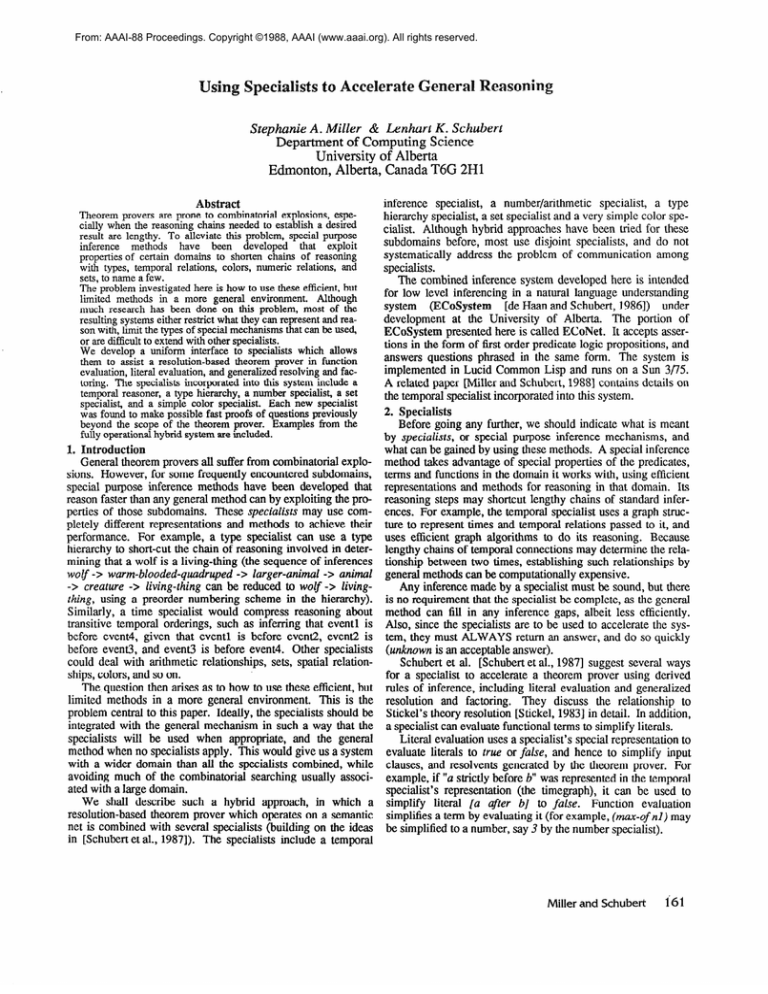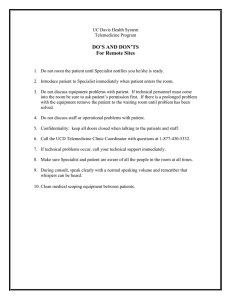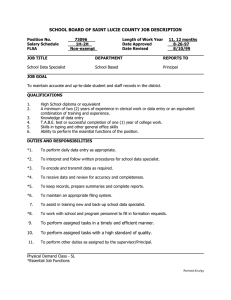
From: AAAI-88 Proceedings. Copyright ©1988, AAAI (www.aaai.org). All rights reserved.
Stephanie A. Miller & Lenhart K. Schubert
Department of Computing Science
University of Alberta
Edmonton, Alberta, Canada T6G 2Hl
inference specialist, a number/arithmetic specialist, a type
hierarchy specialist, a set specialist and a very simple color specialist. Although hybrid approaches have been tried for these
subdomains before, most use disjoint specialists, and do not
systematically address the problem of communication among
specialists.
The combined inference system developed here is intended
for low level inferencing in a natural language understanding
system (ECoSystem
[de Haan and Schubert, 19861) under
development at the University of Alberta. The portion of
Ecosystem presented here is called ECoNet. It accepts assertions in the form of first order predicate logic propositions, and
answers questions phrased in the same form. The system is
implemented in Lucid Common Lisp and runs on a Sun 3/75.
A related paper wller and Schubert, 19881 contains details on
the temporal specialist incorporated into this system.
2. Specialists
Before going any further, we should indicate what is meant
by specialists, or special purpose inference mechanisms, and
what can be gained by using these methods. A special inference
1. Introduction
General theorem provers all suffer from combinatorial explo- method takes advantage of special properties of the predicates,
sions. However, for some frequently encountered subdomains,
terms and functions in the domain it works with, using efficient
special purpose inference methods have been developed that representations and methods for reasoning in that domain. Its
reason faster than any general method can by exploiting the pro- reasoning steps may shortcut lengthy chains of standard inferperties of those subdomains. These specialists may use com- ences. For example, the temporal specialist uses a graph strucpletely different representations and methods to achieve their ture to represent times and temporal relations passed to it, and
performance. For example, a type specialist can use a type uses efficient graph algorithms to do its reasoning. Because
hierarchy to short-cut the chain of reasoning involved in deter- lengthy chains of temporal cormections may determine the relamining that a wolf is a living-thing (the sequence of inferences
tionship between two times, establishing such relationships by
wolf -2 warm-blooded-quadruped -> larger-animal -> animal general methods can be computationally expensive.
-> creature -> living-thing can be reduced &I wolf -> livingAny inference made by a specialist must be sound, but there
thing, using a preorder numbering scheme in the hierarchy).
is no requirement that the specialist be complete, as the general
Similarly, a time specialist would compress reasoning about method can fill in any inference gaps, albeit less efficiently.
transitive temporal orderings, such as inferring that event1 is Also, since the specialists are to be used to accelerate the sysbefore event4, given that event1 is before eve&, event2 is tem, they must ALWAYS return an answer, and do so quickly
before eve&, and event3 is before event4. Other specialists
(unknown is an acceptable answer).
could deal with arithmetic relationships, sets, spatial relationSchubert et al. [Schubert et al., 19871 suggest several ways
ships, colors, and so on.
for a specialist to accelerate a theorem prover using derived
The question then arises as to how to use these efficient, but rules of inference, including literal evaluation and generalized
limited methods in a more general environment. This is the resolution and factoring. They discuss the relationship to
problem central to this paper. Ideally, the specialists should be Stickel’s theory resolution [Stickel, 19831 in detail. In addition,
integrated with the general mechanism in such a way that the a specialist can evaluate functional terms to simplify literals.
specialists will be used when appropriate, and the general
Literal evaluation uses a specialist’s special representation to
method when no specialists apply. This would give us a system evaluate literals to true or false, and hence to simplify input
with a wider domain than all the specialists combined, while clauses, and resolvents generated by the theorem prover. For
avoiding much of the combinatorial searching usually associ- example, if “a strictly before b” was represented in the temporal
ated with a large domain.
specialist’s representation (the timegraph), it can be used to
We shall describe such a hybrid approach, in which a simplify literal [a titer b] to false. Function evaluation
resolution-based theorem prover which operates on a semantic simplifies a term by evaluating it (for example, (m-of nl) may
net is combined with several specialists (building on the ideas be simplified to a number, say 3 by the number specialist).
in [Schubert et al., 19871). The specialists include a temporal
Abstract
Theorem provers are prone to combinatorial explosions, especially when the reasoning chains needed to establish a desired
result are lengthy. To alleviate this problem, special purpose
inference methods have been developed that exploit
properties of certain domains to shorten chains of reasoning
with types, temporal relations, colors, numeric relations, and
sets, to name a few.
The problem investigated here is how to use these efficient, but
limited methods in a more general enviromrrent. Although
much research has been done on this problem, most of the
resulting systems either restrict what they can represent and reason with, limit the types of special mechanisms that can be used,
or are difficult to extend with other specialists.
We develop a uniform interface to specialists which allows
them to assist a resolution-based theorem prover in function
evaluation, literal evaluation, and generalized resolving and factoring. The specialists incorporated into this system include a
temporal reasoner, a type hierarchy, a number specialist, a set
specialist, and a simple color specialist. Each new specialist
was found to make possible fast proofs of questions previously
beyond the scope of the theorem prover. Examples from the
fully operational hybrid system are included.
Miller and Schubert
i61
Generalized resolving and factoring quickly determine
incompatibility or subsumption of one literal by another. This
allows resolution and factoring to be done where they usually
cannot (in one step). For example, the type specialist can
resolve [d dog] against 1 [x animal], to get the null clause,
even though the two predicates are distinct. Similarly, the color
specialist can resolve [x bhe] against [c red] to get the null
clause, even though the signs are the same. The type specialist
can give us generalized factor [d animal] from literals [d dog]
and [x animal]. Similarly, the temporal specialist can factor [T
[x during a] or [x during b]] to [a during b] (if we have [a during b] represented in the timegraph). In addition, even though
we may not have incompatibility, a specialist can determine the
conditions for incompatibility and return these as a residue. A
residue (from Stickel’s partial theory resolution), is a literal or a
set of literals whose negation would make the two literals being
resolved incompatible (resolvable in one or more steps to the
null clause). For example, if we resolve [a before b] against [a
--..--m*
Represents literals for ent or evaluation functions
for simplification pairs ofTi terals for resohion
after b], we get a residue of [a equaZ b]. If that residue is later
or factoring, rem.& of requested evaluations
determined to be false, we have the null clause.
gr
Re resents sim lified functional terms evaluations
As long as the operations a specialist is allowed to perform
of Plterals, rest2 ues from resolving. and factors
from factoring. Alsq, functional terms and literals
are equivalent to sets of standard deductive steps, the specialist
to be evaluated and mterested party specifications
for concepts
is guaranteed to be logically sound. This restriction is satisfied
by the operations we have implemented (literal evaluation, genFigure 1. Architecture of ECoNet
eralized resolving, etc).
members
of
the
curriculum committee are members of the
3. Overview of the System
faculty
council,
we
should be able to figure out that John is a
Having discussed how a specialist can assist a resolutionbased theorem prover, we now need to consider the design of a member of the faculty council. To accelerate reasoning in these
general interface that will allow the theorem prover to invoke areas, the number/arithmetic specialist and the set specialist
the specialists when appropriate. This interface should be gen- were incorporated. The number specialist uses a graph structure
eral enough to handle any specialist we might imagine, and to represent and reason about orderings on integers and real
efficient enough that its cost is modest in comparison with the numbers, and can evaluate numeric functions like add. The set
specialist maintains the contents of sets, and can do simple
savings made possible by the specialists.
ECoNet’s architecture is shown in Figure 1. The core of the operations on sets, like union, intersection, and testing set
system is a resolution-based theorem prover which has been membership.
In addition, there is a very simple color specialist, which
under development at the University of Alberta for several
years, most recently by de Haan [de Haan and Schubert, 19861. currently assumes that all color predicates are disjoint (e.g. btue
The theorem prover uses a semantic net representation, and and red are incompatible). A much better specialist based on a
features automatic topical classif?cation of entered clauses and geometric three-dimensional color space has been designed
organization in a topic hierarchy. The inference method used is [Schubert et al., 19871, which can handle subsumption of colors
resolution, enhanced by topical retrieval of clauses to resolve (e.g., crimson is subsumed by red), intermediate shades (e.g.,
against the problem clauses. Inference is also accelerated by a blue-green), and some modified shades (e.g., sort of brown),
concept hierarchy that enables type inheritance. Since the and will eventually replace this one.
hierarchy specialist is used both for organizing knowledge in 4. The Specialist Interface
the theorem prover, and as a type specialist, it is shown inside
There were several issues to consider in designing the interface. When and how does a specialist get invoked? How is the
the theorem prover box.
The most elaborate specialist in this system is the temporal decision made that a particular specialist is likely to be helpful?
specialist. The system is to be used for natural language under- How can useful information be transmitted between the snecialstanding, which often deals with a number of temporally related ists and the general theorem prover, and between spe&lists?
events or episodes. Reasoning about these orderings, as well as To answer these questions, we first need to review how the genthe quantitative aspects of time (durations and dates) is eral theorem prover works. Figure 2 shows a high level absuacrequired. As mentioned earlier, such inferences in a general tion of the algorithm used by the general theorem prover, with
theorem prover can be computationally expensive. Details of notes in bold print showing where the various specialist operathe
temporal
specialist
can
be
found
in tions described earlier fit.
[Miller and Schubert, 19881.
An agenda is used to keep track of possible actions which
Temporal reasoning is certainly not the only domain requir- can be used to carry out a proof - resolving actions and access
ing potentially
explosive inferencing.
Reasoning about actions. A successful resolving action causes the resolvent to
numbers, and about set membership are also problems which be entered; a successful access action causes clauses to be
we will have to deal with, even for understanding ordinary retrieved which are likely to resolve against a particular clause.
discourse. For example, if we are told that eleven of twelve Agenda items are ordered so that the action most likely to result
jurors agreed on a guilty verdict, we should be able to figure out in success (i.e. the null clause) is at the top. When given a
that exactly one juror demurred. Similarly, if we are told that question, the theorem prover starts with the clauses correspondJohn is a member of the curriculum committee, and all ing to the question, and the clauses corresponding to the nega-
162
Automated
Reasoning
tion of the question, and enters both sets just like resolvents
(and flags them appropriately). The classification phase of this
entry will add the first access actions to the agenda. If a contradiction is eventually derived from the question clauses and
the knowledge base, the answer will be NO (hence it is called
the disproof attempt); with the negation of the question clause,
the answer will be YES (the proof attempt). The proof and disproof attempts are carried out concurrently, using a common
agenda.
Assertion
Simplify asserted clause
-> literal evaluation
-> function evaluation
Classify asserted clause
Enter into Semantic net and concept and topic hierarchies
-> entry into specialists’ representations
Question
Loop through agenda; take top item from agenda:
If Resolving Action:
Calculate resolvent
Simplify resolvent
-> literal evaluation
-> function evaluation
Classify resolvent and add relevant access actions
to agenda
Check for factoring possibilities
-> generalized factoring
Enter into semantic net and concept and topic hierarchies
If Access action (involves ckzuse, fopic, and concepf):
Compare each clause retrieved under topic of concept
with the given clause
If resolvable, add a resolving action to agenda
-B generalized resolving
Figure 2. Overview of Algorithm
During an access action where literals are being compared
for resolvability, if the traditional test fails (same predicate,
different signs), a specialist could potentially find a generalized
resolving action. “Generalized resolutions” found by the specialists are added directly to the agenda. Similarly, if a factoring test fails (same predicate, same sign), a specialist might find
a generalized factor.
Clause simplification involves both literal evaluation and
function evaluation (a form of term simplilication), both of
which a specialist may assist with. Even if a literal or its negation have not been asserted before, a specialist may be able to
detect its truth or falsity.
In all of these cases, a decision process must be invoked that
can quickly decide which specialists, if any, apply, and invoke
them.
4.1. Extensions to the Theorem R-over
To get maximum flexibility for the specialists and the specialist interface without sacrificing efficiency, some enhancements to the theorem prover were needed.
4.1.1. Expressiveness
First, some syntactic refinements were needed. To enable
the specialist interface to decide when a specialist is appropriate
for some problem, terms serving as predicate arguments should
be sortally distinct, so that predications about physical objects,
events, numbers, and so on, are easily distinguished from each
other. (Predicates alone do not necessarily determine their
argument sorts in our system. For example, the predicate equal
may relate a number of different kinds of entities, including
events or numbers.) This is accomplished by allowing a “sort
tag” to accompany an argument, expressed by following the
term with an underscore and the sort. Possible sorts include:
physical object, event/episode, time, number, symbolic expres-
sion and set. Sorts are considered pairwise disjoint (in contrast
with types, which in this system are unary predicates whose
extensions may overlap).
Also, some entities, such as numbers, structured values, and
symbolic expressions are not easily expressed as semantic net
concepts, or are too numerous to represent that way. For example, we do not want an individual concept for every possible
number! To avoid this problem, we allow quoted expressions
as terms. For example, the functional expression (date ‘1987
mm-number ‘1 ‘0 ‘0 ‘0) evaluates to a quoted expression
representing a structured value, ‘(time 1987 mm I 0 0 0), which
is an absolute time representation recognized by the time specialist. A quoted atom is assumed to denote the string of characters making up the atom. For example, the denotation of
‘Mary is the string of alphabetic characters ‘Mary”, and the
denotation of ‘35 is the string of numerals “35”. By formally
identifying the natural numbers with the strings of numerals
normally used to represent them (in base lo), we ensure that
quoted numerals are denotationally equivalent to unquoted
ones’. The denotation of ‘(t 1 t2 . ** t,) is the tuple consisting
of the denotation of t 1, followed by the denotation of t2, . ... followed by the denotation of t, . Thus, the above structured value
is the 7-tuple whose lirst element is the string “time”, and whose
remaining elements are numbers (the second one of these being
whatever number is denoted by mm). Note that although this
structured value looks very similar to the original functional
term, if the terms for the function had been more complex (like
(add ‘I ‘1986) instead of ‘1987), the quoted expression would
look considerably simpler than the original term. Term
simplification is done bottom up, and guarantees to the specialists that when they are invoked with a literal or functional term,
the terms have been simplified as much as possible. This
allowed simpler and more elegant implementations of the interface and specialists.
Because the “generalized resolutions” performed by specialists do not necessarily involve identical predicates, and may do
the work of many ordinary resolution steps, the order of
unification of arguments in two literals need not be the same.
This is decided by the specialists, and details depend on the
axiomatization (theory) assumed to underlie the specialist’s
domain. After the specialists have decided in what order the
arguments should be unified when resolving or factoring, they
invoke the unification process themselves. If a factoring or
resolving action results, the specialist passes these substitutions
back to the theorem prover.
Specialists may also return a residue (see example given earlier). The theorem prover has to incorporate this residue into
the resolvent.
Also, when attempting to resolve, specialists may provide
more than just substitutions and residues - they may also supply
the evaluations of the two literals after substitution. Then, even
if the two literals are not incompatible, we can use the evaluations to simplify the clauses. For example, when resolving --, [x
before a] in [-I [x before a] I [x during a]] against a clause containing literal [b after y], and if furthermore, we have “a strictly
before b” represented in the timegraph, we can simplify the first
clause to 1 [b before a]. This simplification will then be added
to the clauses to be considered.
This enables us to confine numbers to quoted contexts, which turns out
to be computationally convenient.
Miller and Schubert
163
ists need not know which other specialists can help them. Two
4.2. The Decision Process
This section briefly outlines how the specialists are selected types of communication have been implemented for the specialfor each operation they may perform.
Details are in ists: immediate evaluation, where a specialist asks for the
[Miller, 19881. The mechanism for deciding which specialists evaluation of a particular functional term or literal, and delayed
should be called is just a cursory check to find specialists that communication, where the specialist is notified that something
are likely to be interested. Since much of the time no specialist of interest in another domain has been asserted. Immediate
will be involved, we do not want to waste too much time decid- evaluation may be useful during either assertion or question
ing which, if any, to call. To get quick and easy access to the answering, while delayed communication can only be used to
specialists that may be useful, they are kept on the predicate’s further enhance asserted information.
5.1. Immediate Evaluation
or function’s property list.
4.2.1. Literal Entry and Evaluation
For immediate evaluation, the functional term or literal is
For literal entry and evaluation, the predicate involved, and sent out from the specialist to the specialist interface for evaluaits first argument are used to determine which specialist to call. tion. The interface decides which specialist(s) will be able to
The specialist itself is responsible for checking the other argu- evaluate it as described earlier, and passes the item on. The
ments to ensure that they are in its domain. Another possibility
result (a concept or quoted expression for a functional term; yes,
was to use pattern matching on the predicate-argument patterns, no, or unknown for a literal), is sent back to the specialist that
but this can be quite slow. On entry, all applicable specialists requested it. In the previous example, the temporal specialist
and use that value in
are called, as any one might later be required to use the informa- could request the value of (max-of ~GWZ)~,
tion in inferencing. For literal evaluation, each specialist is the absolute time specification.
called, one at a time, mtil an answer other than unknown is 5.2. Delayed Communication
A specialist can communicate to the interface a particular
returned. For example, asserting [nl-integer less-than r2_real]
concept (currently only constants) it wants “watched”, and a
would cause the number specialist to be invoked to enter it.
literal to reassert when something involving that concept is
4.2.2. Generalized Resolution and Factoring
For generalized factoring and resolution, the two predicates asserted. This information is kept on m interested party list for
alone are used to decide which specialists to call, using the the concept. Whenever anything new is asserted about that conintersection of the lists of interested specialists for each. No cept, each literal on the interested party list is reasserted to the
checking is done on arguments yet, as unification has not taken specialist that put it there. There is no point asserting the new
place (and cannot until the specialist decides how it is to be literal to an interested specialists because it may not recognize
done), and substitutions may be involved. Final checks on the predicates and terms involved. In the previous example, the
whether the resulting literals (after unification and substitution)
temporal specialist would add an entry to mm’s interested party
are in a specialist’s domain must be done by the specialist. For list, consisting of the specialist (time-specialist) and the literal
example, when resolving
given to the temporal specialist (after term evaluation) [el
[tl-time before t2_time] vs [x equal t3 time],
before ‘(time 1987 mm 1 12 0 O)]. Later, if [mm less-than ‘31
both predicates have the temporal special% on their property were asserted, [el before ‘(time 1987 mm 1 12 0 0)] would be
lists (although equal has other specialists as well), and so only re-asserted to the temporal specialist.
that specialist would be called to try to resolve them. All appli- 6. Example
cable specialists are called for both generalized resolving and
The system can answer questions which involve mixed reafactoring, as each may find different resolving or factoring soning - both specialist inference and ordinary resolution. The
actions.
example in Figure 3 from the story of Little Red Riding Hood
4.23. Function Evaluation
shows a few capabilities of the system. The example does not
The function alone is used to determine which specialist(s)
show either the number or set specialists, as examples involving
to call. All arguments are simplified before the function is them were too lengthy to include. Currently the number speevaluated, recursively. For example
cialist is used mainly to support the temporal specialist by
(date (add ‘1987 ‘I) ‘4 ‘1 ‘12 ‘0 ‘0)’
assisting it in maintaining the most constrained absolute times
would first use the number specialist to calculate the year argu- and durations. The set specialist is quite new and its capabiliment, and then the temporal specialist to calculate the absolute ties have not been fully exploited in our Little Red Riding Hood
time with all the arguments
knowledge base yet.
5. Communication between Specialists
7. Comparison with Other Approaches
Sometimes a specialist may need additional information to
ECoJet’s representational capabilities allow it to handle
complete its task, and it is possible that another specialist may first order predicate calculus, minus equality. (The specialists
be able to supply it. For example, assertion of
provide partial handling of equality, but full equality reasoning
[el-episode before (date ‘1987 nun number ‘01 ‘12 ‘00 ‘OO)]
should be added to the general theorem prover). The specialwould require that the time specia&t ask about the bounds of ists, in principle, are used only to accelerate inference. This
mm (the territory of the number specialist). Similarly, a naive differentiates it from systems like KL-TWO [V&in, 19851,
or qualitative physics specialist might need to know if the event where the core of the system is a computationally efficient subof the robot hand going across the table happened before or set of first order logic, and the specialist (a terminological inferafter the vase of flowers was placed there in order to determine
ence mechanism) adds both to the overall expressiveness and
the current position of the vase. Also, when the information
reasoning power of the system.
requested is not immediately available, or likely to be further
’ We always want the most complete, but correct information available.
constrained by clauses added later (for example, bounds on Since mm can never get bigger than its maximum, this is the safest bound to
numbers), we want the specialist to be not&d if and when it is. use on assekon. However, if we were trying to evaluate this literal, we would
use the minimum, since if el were less than the minimum of that time. we can
The essential idea of our approach is to channel all communbe assured that it will be less than any other value that time might have.
ication between specialists through the interface. Thus special-
164
Automated
Reasoning
; did a creature kill the wolfwhile he was in the cottage?
==> ?(E J E z-ep (y kill W z) & (y creature)
& (z during wolf-in-cot))
Entering proof clauses:
((- U-VAR-1 CREATURE) I (” U-VAR-1 KILL W EPISODE-VAR-1)
I (- EPISODE-VAR-1 DURING WOLF-II?-COT))
Using the temporal specialist:
Time Sue&list: Truing to resolve
(- EPiSODE-VA%l-DURING WOLF-IN-COT)
against (WOLF-DEMISE DURlNG-l-0 WOLF-IN-COT)
T$e Specialist: Resolved with evaluation: NO with substitutions:
((EPISODE-VAR- 1 by WOLF-DEMISE 2))
Resolved (- EPISODE-VAR- 1 DURING WOLF-IN-COT) iu the proof clause
((- U-VAR.1 CREATURE) I (- U-VAR- 1 KILL W EPISODE-VAR.1) I
(- EPISODE-VAR.1 DURING WOLF-IN-COT))
against (WOLF-DEMISE DURING-l -0 WOLF-IN-COT) iu
(WOLF-DEMISE DURING- 1-OWOLF-IN-COT)
yielding . . .
((- U-VAR.1 CREATURE) I (- U-VAR.1 KILL W WOLF-DEMISE))
Ordinary resolution:
Resolved (- U-VAR- 1 KILL W WOLF-DEMISE) iu the proof clause
((- U-VAR.1 CREATURE) I (- U-VAR.1 KILL W WOLF-DEMISE))
against (WOODCUTTER KILL W WOLF-DEMISE) in
(WOODCUTTER KILL W WOLF-DEMISE)
yielding . ..
(-WOODCUTTER CREATURE)
Using the type hierarchy specialist:
Resolved (- WOODCU’ITER CREATURE) in the proof clause
(-WOODCUTTER CREATURE)
against (WOODCUTTER MAN) iu (WOODCUTTER MAN)
yielding the null clause.
YES
8. Were all the capes blue?
==> ?(A x (x cape) =B (x blue))
Entering disproof clauses:
((- U-VAR.1 CAPE) I (U-VAR.1 BLUE))
Using the color specialist:
Resolved (U-VAR.1 BLUE) iu the disproof clause
((- U-VAR.1 CAPE) I (U-VAR-1 BLUE))
against (SCON-340 RED) in (SCON-340 RED)
yielding .. .
(- SCON-340 CAPE)
(SCON-340 CAPE) evaluated to YES.
The clause evaluated to NO.
NQ
Figure 3. Example of ECoNet in operation3
Another hybrid, Krypton [Bra&man et al., 119851 has a
powerful core system, also enhanced with a terminological specialist. It is unclear whether the technique used to integrate this
specialist could be used for other specialists as well (like time).
Krypton is one of the few other systems that actually allow the
specialists to do generalized resolving. However, the residues
calculated by Krypton can be quite complex, involving
quantification. Although ECoNet has no constraint on the complexity of residues that a specialist may create, the specialists
implemented so far generate quite simple residues, further simplifying the resolving process.
The domain independent special mechanisms used by Bundy
et al. [Bundy et al., 19821 allow for more than one specialist,
but all must be in the form of specialized logical rules (precluding more efficient representations, like graphs). The only hmitations on the specialists that may be incorporated into ECoNet
are that they must make sound inferences.
Another thing that makes ECoNet unique is the communication among specialists. Although some earlier systems did have
3 This example shows actual output of the system, edited for clarity aud
brevity. Bold prmt is user input; comments iu italics; the rest, system output.
The timegraph contained, among other relations, that wolf-demise (episode
correspoudiug to the wolf being killed) is during wolf-in-cot (episode
corresponding to the wolf beiig in the cottage). [a during-l -0 b] => [(start-of
a) > (start-of b)] & [(end-of a) = (end-of b)].
some forms of communication (for example, Nelson and Oppen
[Nelson and Oppen, 19791, and Shostak [Shostak, 1984]), only
equalities could be communicated. ECoNet is much more flexible, and unlike these systems, does not require that the specialists be disjoint (no overlapping functions or predicates).
8. Conclusions
Our intent was to combine efficient special methods with a
general purpose theorem prover in such a way that the
efficiency of the special methods ‘averts the combinatorial
explosions usually associated with a general theorem prover.
Previous approaches limit the overall domain, or cannot easily
accomodate a variety of specialists, or don’t fully exploit the
specialists’ capabilities.
The interface we developed allows specialists to accelerate
the resolution-based theorem prover in literal evaluation, function evaluation, and generalized resolution and factoring. In
addition, assertions are given to the specialists to store in their
own representations. Several specialists were incorporated into
the system using the interface, including a type specialist, a
temporal specialist. a number/arithmetic specialist, a set/list
specialist, and a very simple color specialist. Communication
between specialists is achieved by allowing specialists to
request evaluation of functional terms or literals, and by maintaining interested party lists to notify specialists that something
of interest to them has been derived. The temporal and number
specialists communicate through absolute time and duration
specifications.
Experience with the interface conkms that new specialists
can be added with relative ease. This is because the specialists
interact with the general theorem prover in a small, fixed set of
ways. Each new specialist was found to make possible fast
proofs of questions previously beyond the scope of the theorem
prover.
eferemes
[Bra&man et al., 19851 Ronald J. Bra&man, Victoria Pigman Gilbert
ancl Hector J. Leveque, An Essential Mybrid Reasoning System:
Knowledge
and Symbol
Level Accounts
of KRYPTON,
Proceedings of IJCAI-85 I, (1985), 532-539.
~und~&alll9~.n
B;;dy, JLa;;;ce
Byrd and Chris Mellish,
Jndependent, Inference
Mechanisms, Proc: E&U-82, Grsay, France, 1982, 67-74.
[de Haan and Schubert, 19861 Johannes de Maan and Lenhart K.
SchuM
Inference in a Topically Organized Semantic Net,
Proc. M-86
I, (1986), 334-338.
[Miller and Schubert, 19881 Stephanie A. Miller and Lenhart K.
Schubert., Time Revisited, CSCSZ-88, Edmonton, Alberta, 1988.
[Miller, 19881 Stephanie A. Miller, Time Revisited, M.Sc. Thesis,
Department of Computing Science, IJniversity of Alberta, 1988.
melson and Oppen, 19791 Greg Nelson
and Derek C. @pen,
Simplification
by Cooperating
Decision
Procedures,
ACM
Transactions
on Progrmnnaing Languages and Systems 1, 2
(1979). 245-257.
[Schubert et al., 19871 L.K. Schubert, MA. Papalaskaris and J.
Taugher, Accelerating Deductive Inference: Special Methods
for Taxonomies, Colours and Times, in The Knowkdge Frontier,
N. Cercone and G. McCalla (ed.), 1987.
[Shostak, 19841 Robert E. Shostak. Deciding Combinations of
Theories, JournuZ ofthe ACM 31, 1 (1984), 1-12.
[Stickel, 19831 Mark E. Stickel, Theory Resolution: Building in
Nonequational Theories, Proc. AAAI-83, Washington, DC.,
1983.391-397.
[Vilain, 19851 Marc Vilain, The Restricted Language Architecture of a
Hybrid Representation System, Proceedings
of IJCAI-85 I,
(1985), 547-551.
Miller and Schubert
165







